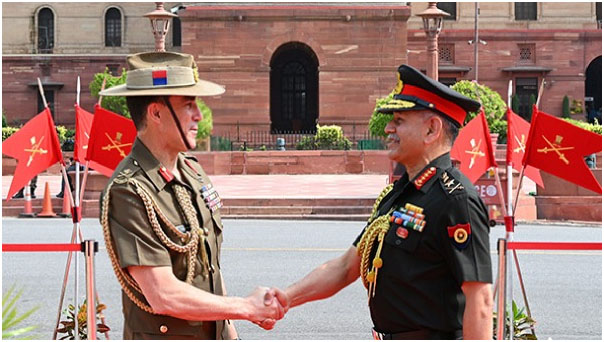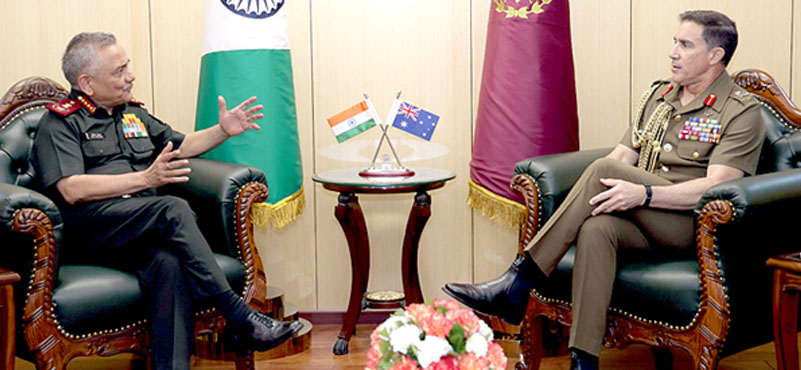Australian Army Chief, Lieutenant General Simon Stuart’s visit to India from 10 to 14 August 2025 marks a pivotal moment in the growing military partnership between India and Australia. Incidentally General Upendra Dwivedi and he trained together at United States Army War College in 2015, forging a professional relationship.
This visit underlines that deepening Army-to-Army ties are crucial to strategic stability in the Indo-Pacific, as the relationship moves from symbolic engagement to a central pillar of regional security strategy at a time when both nations are facing a most complex geostrategic environment.
This follows the visit of the CDS General Anil Chauhan to Australia in March which underscored the growing engagement between the two nations under the Comprehensive Strategic Partnership, emphasizing shared commitment towards regional security and military collaboration.
Going back in history both armies first fought together on the beaches of Galipolli in World War I, Joan Baez in her song ‘And the Band Played Waltzing Matilda’ writes about the intensity of the battle when she said how the Australian troops ‘were butchered like lambs at the slaughter’ and the pain endured ‘never knew there was worse things than dying’. In November 2014, Prime Minister Narendra Modi presented a silver replica of the statue of the Indian soldier of the 14 Ferozpur Sikhs to his then host Prime Minister Tony Abbot of Australia. Indian troops again fought alongside Australia in World War II and in fact 18 Cavalry, the Regiment I belong to, was part of the Siege of Tobruk alongside 9 Australian Division. Fought in the vast and unforgiving landscapes of the North African desert, the battle remains a symbol of resilience, courage, and strategic importance during World War II. Many years later, soon after the 1962 war, Australia was part of the then famous exercise, Exercise Shiksha, conducted in 1963 to evaluate our air defence systems.
This visit by the Australian Army Chief has been preceded by a host of interactions, including Deputy Prime Minister and Defence Minister Richard Marles, who was in Delhi in June to mark the fifth anniversary of the Australia-India Comprehensive Strategic Partnership. This was followed by Australian Foreign Minister Penny Wong meeting with External Affairs Minister S Jaishankar at the Quad Foreign Ministers’ meeting in Washington on 01 July 2025.
As both countries seek to maintain a free and rules-based order in the Indo-Pacific amid increasing regional volatility, their Army-to-Army partnership is quietly emerging as the backbone of their strategic alignment, where concrete cooperation on the ground translates into broader regional influence.

The Land Domain in an Indo-Pacific Context
While conversations about Indo-Pacific security often sail on maritime currents—focusing on sea lines of communication, port diplomacy, and naval deployment, it is important to recognise the vital role land forces play in deterrence, humanitarian relief, grey-zone stability, and counter-terrorism.
India and Australia, as continental powers recognise that regional security relies on land-centric capability, cooperation, and command-level trust. Hence the Army-to-Army partnership exemplifies this recognition as the two Armies engage across the spectrum from combat drills to command trust.
Both countries are part of the QUAD which is an important grouping and mechanism against Chinese dominance.
Both Army Chiefs held discussions to enhance bilateral defence cooperation and deepen military-to-military engagement for regional stability and global peace. He also engaged in high-level discussions with senior military leaders wherein he was briefed on Operation SINDOOR and India’s security perspective.
General Stuart also met the Chief of Defence Staff General Anil Chauhan, Chief of Naval Staff Admiral Dinesh Kumar Tripathi, Chief of Air Staff Air Chief Marshal A P Singh, and Defence Secretary Rajesh Kumar Singh, according to a post of the Headquarters Integrated Defence Staff on X.
On the sidelines of the visit, the Regimental Sergeant Major of the Australian Army met the Army Subedar Major of the Indian Army, fostering camaraderie and collaboration between all ranks.
On 12 August, General Stuart visited 50 (Independent) Parachute Brigade at Agra before returning to New Delhi to deliver a keynote address at the National Defence College.
On 13 and 14 August, the Chief of the Australian Army proceeded to Pune, where he interacted with Lieutenant General Dhiraj Seth, General Officer Commanding-in-Chief, Southern Command, and visited the National Defence Academy, Khadakwasla and spoke on “Collective Security: An Era of Great Power Competition”. He underscored the importance of interoperability, mutual trust, and coordinated response capabilities in countering evolving security challenges, in an increasingly volatile geo-political environment,”
The discussions between Southern Army Commander and Australian Army “reaffirmed the shared commitment of the Indian Army and Australian Army to foster stronger military ties and enhance strategic engagement.”

AUSTRAHIND: From Tactical Learning to Operational Readiness
At the operational level, Exercise AUSTRAHIND is the cornerstone of bilateral land force engagement. Launched in 2016, this exercise has steadily grown from a counter-terrorism drill to a full-spectrum, close-quarter battle and tactical interoperability exercise between the Indian Army and Australia’s 1st Brigade.
The next edition, scheduled for Australia in November this year , will immerse troops in simulated battles across jungles, in urban sprawls and contested grey zones. These exercises develop new tactics and joint plans in real-time.
This focus on confronting modern threats emphasies a central takeaway: real-time tactical collaboration directly addressing the evolving security context both countries face.
Institutionalised Dialogue: From Meetings to Mission Planning
The Army-to-Army Staff Talks, initiated in 2010 and held annually since 2016, have matured into a reliable mechanism for strategic alignment, doctrinal exchange, and capability planning. These talks are not bureaucratic placeholders; rather, they serve as platforms for forward-looking cooperation in areas such as humanitarian assistance and disaster relief (HADR) readiness, counter-terrorism doctrine, peacekeeping deployments, and the sharing of knowledge on jungle warfare.
The two countries had signed a “Comprehensive Strategic Partnership” in 2020, which has manifested in bilateral visits and armed forces interactions rising significantly.
This complements broader frameworks, such as the 2+2 Ministerial Dialogue (last held in November 2023 in New Delhi) and the Defence Policy Talks (held in July 2023 in Australia). Importantly, these platforms provide an agile space for the two countries to synchronise not just bilateral priorities but regional responses from post-cyclone logistics to capacity-building in Southeast Asia.
In mid-March, the 9th edition of India-Australia Defence Policy Talks was held, preceded by talks at Ministerial and Secretary levels. Australia now designates India as a “Top-tier Defence Partner”.

A Doctrinal and Tactical Learning Ecosystem
Indian and Australian officers are embedded across each other’s premier institutions — from the National Defence College and Defence Services Staff College (DSSC) in India, to Australia’s Army Command and Staff Course and Strategic Studies Programme. These exchanges have allowed both armies to develop not only shared operational language but a shared strategic grammar.
The Instructor Exchange Programme at India’s Counter-Insurgency and Jungle Warfare (CIJW) School in Vairengte is particularly noteworthy. It signals not just a transfer of tactical expertise, but a willingness to learn from each other’s combat experiences from Kashmir and the Northeast to the South Pacific and Timor-Leste.
The Subject Matter Expert Exchanges (SMEEs) and the Alumni Connect programme (‘Dosti and Mateship in Defence’, March 2024) serve to institutionalise continuity across generations of officers.
Future Leadership: An Investment in Strategic Trust
Perhaps one of the most forward-looking initiative is the India–Australia Young Officers Exchange Programme, conceptualised by the late General Bipin Rawat and formally launched during the 2022 virtual summit between Prime Ministers Modi and Albanese. By embedding junior officers in each other’s units and training environments, the two armies are investing in a cadre of leaders who won’t just be tactically interoperable but will be strategically synchronised.
In future multinational operations — be it HADR, United Nations (UN) peacekeeping, or coalition deterrence posturing — this kind of relational trust will be far more valuable than any single agreement or joint communiqué.
Industry Engagement: From Transactions to Collaboration
Defence cooperation isn’t limited to uniforms and drills alone. Indian defence Companies have begun exporting tactical intelligence, surveillance, and reconnaissance (ISR) platforms, as well as protected mobility vehicles and battlefield systems, to Australia. Collaborative development between the Army Design Bureau (ADB) and Australia’s Digger Works is also being explored, with an eye on cost-effective, combat-proven battlefield technologies.
This model cooperation between land forces and co-development between industry partners could serve as the template for Indo-Pacific defence industrial alignment. It also demonstrates the Indian Army’s rising profile in the indigenous research and development (R&D) and export ecosystem.
While Australian defence firms are largely linked to US firms as Original Equipment Manufacturers, a range of partnership opportunities exist for the benefit of both countries.
While in Pune the Australian Army Chief visited Bharat Forge Limited where indigenous manufacturing capabilities of the private Indian defence industry were showcased.
Conclusion
Lieutenant General Stuart’s visit to India highlights the deepening Army-to-Army relationship and demonstrates that cooperation between land forces is critical to Indo-Pacific security which has become the fulcrum of 21st-century geopolitics, where partnerships and power dynamics are evolving.
As two democracies with a vested interest in a free and open Indo-Pacific, both countries have recognised the strategic imperative of working closely on military and maritime security issues. Within this context, India and Australia have emerged as strategic partners, deepening their defence and security ties to uphold a stable, rules-based regional order. In an era of elusive threats and shifting alliances, robust Army ties anchor and advance bilateral and regional stability.
This relationship, built on realism, respect, and operational trust, reflects the Indian Army’s emergence not just as a force of deterrence but as a partner of consequence. For the Indo-Pacific to remain free, stable, and multipolar, such bilateral military compacts, grounded in land and rooted in trust, will matter more than ever.
The visit marks a step forward in operational synergy as both nations embark on deeper engagement.
ABOUT THE AUTHOR
 Maj Gen VK Singh, VSM was commissioned into The Scinde Horse in Dec 1983. The officer has commanded an Independent Recce Sqn in the desert sector, and has the distinction of being the first Armoured Corps Officer to command an Assam Rifles Battalion in Counter Insurgency Operations in Manipur and Nagaland, as well as the first General Cadre Officer to command a Strategic Forces Brigade. He then commanded 12 Infantry Division (RAPID) in Western Sector. The General is a fourth generation army officer.
Maj Gen VK Singh, VSM was commissioned into The Scinde Horse in Dec 1983. The officer has commanded an Independent Recce Sqn in the desert sector, and has the distinction of being the first Armoured Corps Officer to command an Assam Rifles Battalion in Counter Insurgency Operations in Manipur and Nagaland, as well as the first General Cadre Officer to command a Strategic Forces Brigade. He then commanded 12 Infantry Division (RAPID) in Western Sector. The General is a fourth generation army officer.
 Major General Jagatbir Singh was commissioned into 18 Cavalry in December 1981. During his 38 years of service in the Army he has held various command, staff and instructional appointments and served in varied terrains in the country. He has served in a United Nations Peace Keeping Mission as a Military Observer in Iraq and Kuwait. He has been an instructor to Indian Military Academy and the Defence Services Staff College, Wellington. He is a prolific writer in defence & national security and adept at public speaking.
Major General Jagatbir Singh was commissioned into 18 Cavalry in December 1981. During his 38 years of service in the Army he has held various command, staff and instructional appointments and served in varied terrains in the country. He has served in a United Nations Peace Keeping Mission as a Military Observer in Iraq and Kuwait. He has been an instructor to Indian Military Academy and the Defence Services Staff College, Wellington. He is a prolific writer in defence & national security and adept at public speaking.








